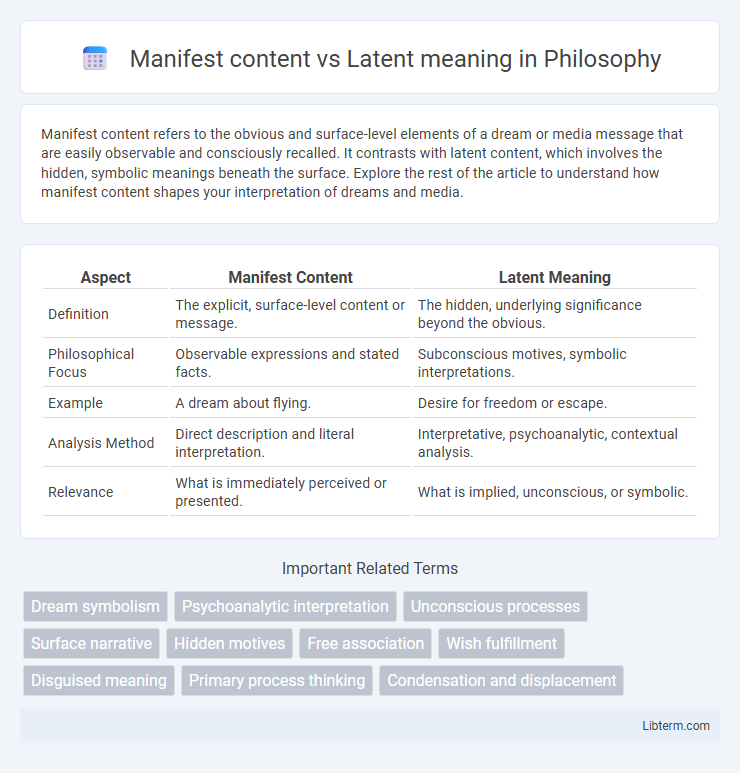Manifest content refers to the obvious and surface-level elements of a dream or media message that are easily observable and consciously recalled. It contrasts with latent content, which involves the hidden, symbolic meanings beneath the surface. Explore the rest of the article to understand how manifest content shapes your interpretation of dreams and media.
Table of Comparison
| Aspect | Manifest Content | Latent Meaning |
|---|---|---|
| Definition | The explicit, surface-level content or message. | The hidden, underlying significance beyond the obvious. |
| Philosophical Focus | Observable expressions and stated facts. | Subconscious motives, symbolic interpretations. |
| Example | A dream about flying. | Desire for freedom or escape. |
| Analysis Method | Direct description and literal interpretation. | Interpretative, psychoanalytic, contextual analysis. |
| Relevance | What is immediately perceived or presented. | What is implied, unconscious, or symbolic. |
Introduction to Manifest Content and Latent Meaning
Manifest content refers to the explicit, surface-level elements of a text, image, or dream, representing what is clearly observable and directly communicated. Latent meaning, by contrast, involves the deeper, hidden, or symbolic significance that requires interpretation beyond the obvious content. Understanding the distinction between manifest content and latent meaning is crucial for analyzing psychological phenomena, literature, and media, as it reveals underlying themes and unconscious motivations.
Defining Manifest Content
Manifest content refers to the explicit, surface-level information or events directly observable in texts, dreams, or communication without interpretation. It encompasses the clear, concrete elements that are consciously noted, such as dialogue, actions, or images. Understanding manifest content is essential for distinguishing between what is immediately presented and the underlying latent meaning that requires deeper analysis.
Understanding Latent Meaning
Latent meaning refers to the hidden or underlying significance within a text, often revealing deeper psychological or symbolic insights beyond the explicit content. Understanding latent meaning requires analyzing context, cultural cues, and subconscious elements that shape interpretation in fields like psychoanalysis and literary criticism. Recognizing latent meaning enhances comprehension of nuanced themes and unspoken messages embedded in communication.
Key Differences Between Manifest Content and Latent Meaning
Manifest content refers to the explicit, surface-level information or events directly observed in a text or dream, while latent meaning involves the underlying, hidden, or symbolic interpretation beneath that surface. Key differences include that manifest content is concrete and easily identifiable, whereas latent meaning requires deeper analysis to uncover the subconscious or abstract significance. Understanding these distinctions is crucial in fields like psychoanalysis and literary studies for accurate interpretation.
Importance in Communication and Analysis
Manifest content represents the explicit, surface-level information in communication, essential for ensuring clear understanding and immediate interpretation. Latent meaning involves the underlying, implicit messages that reveal deeper insights, critical for comprehensive analysis and uncovering hidden intentions. Recognizing both manifest content and latent meaning enhances effective communication, decision-making, and accurate interpretation in fields like psychology, media studies, and cultural analysis.
Examples of Manifest Content in Everyday Life
Manifest content refers to the clear, surface-level meaning of information, such as a news headline stating "City Council Approves New Park." Everyday examples include road signs indicating speed limits, emails explicitly scheduling meetings, and advertisements directly promoting products. These instances convey explicit, straightforward messages easily understood without deeper interpretation.
Uncovering Latent Meaning: Techniques and Methods
Uncovering latent meaning involves techniques such as thematic analysis, content analysis, and psychoanalytic interpretation, which go beyond the manifest content to reveal underlying messages and subconscious motives. Methods like narrative analysis and discourse analysis help identify hidden patterns, symbols, and ideologies embedded within texts, providing deeper insights into cultural and psychological contexts. Employing coding strategies and triangulation enhances the reliability of interpreting latent content in qualitative research.
Role in Psychology and Literature
Manifest content represents the literal storyline or surface details of dreams, texts, or communications, serving as the observable data for psychological analysis and literary interpretation. Latent meaning uncovers the hidden psychological motivations, unconscious desires, and symbolic messages embedded within the manifest content, playing a critical role in psychoanalytic theory and deep literary critique. In both psychology and literature, exploring the interaction between manifest content and latent meaning facilitates a deeper understanding of human behavior, unconscious processes, and thematic complexity.
Applications in Media and Cultural Studies
Manifest content refers to the explicit, surface-level elements of media texts such as images, dialogue, and plot, while latent meaning encompasses the implicit, underlying messages shaped by cultural, social, and ideological contexts. In media and cultural studies, analyzing manifest content allows researchers to identify overt themes and representations, whereas exploring latent meanings uncovers deeper societal norms, power dynamics, and cultural values encoded within media artifacts. This dual approach enhances critical media literacy, enabling scholars to interpret how media both reflects and constructs social realities.
Conclusion: Integrating Manifest and Latent Perspectives
Integrating manifest content and latent meaning enhances comprehensive data interpretation by combining explicit information with underlying significance. This dual approach deepens analytical accuracy, revealing both surface-level facts and hidden patterns within qualitative data. Leveraging both perspectives fosters richer insights essential for nuanced understanding in fields like psychology, media analysis, and communication studies.
Manifest content Infographic

 libterm.com
libterm.com